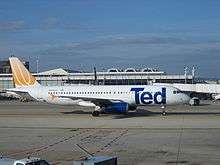Ted (airline)
 | |||||||
| |||||||
| Founded | 2003 | ||||||
|---|---|---|---|---|---|---|---|
| Commenced operations | February 12, 2004 | ||||||
| Ceased operations | January 6, 2009 (now operated by United Airlines) | ||||||
| Hubs | |||||||
| Secondary hubs | |||||||
| Frequent-flyer program | Mileage Plus | ||||||
| Airport lounge | Red Carpet Club | ||||||
| Alliance | Star Alliance | ||||||
| Parent company | UAL Corporation | ||||||
| Headquarters | Elk Grove Township, Cook County, Illinois | ||||||
| Key people | Glenn Tilton (CEO) | ||||||
Ted was one of two airline divisional brands of United Airlines. It targeted vacation locations in the low cost airline market, in contrast to United's high end divisional "sub-fleeted" brand called United p.s.. "Ted" comes from the last three letters in the United brand name.[1] United marketed Ted anthropomorphically and attempted to personify Ted; it used phrases such as Meet Ted or I've Met Ted.
Due to the airline crisis caused by spiking fuel prices, on June 4, 2008, United announced that the Ted brand and services would be discontinued with the Ted aircraft being fitted with United's First Class cabin and eventually being incorporated into United's regular fleet to compensate for the removal of United's entire Boeing 737 fleet. Operations were folded back into the mainline brand on January 6, 2009.
History
Ted's creation was announced November 12, 2003, and service began February 12, 2004. It began service in Denver International Airport, a United hub, to compete with Frontier Airlines. The airline had 56 Airbus A320s with 156 all-economy seats, allowing United to compete with low-cost airlines such as Frontier Airlines. All Ted flights were operated by United crews flying under the UAL operating certificate, as Ted was not actually a certificated airline, but rather a brand name applied to differentiate the all-economy service from United's mainline flights. Therefore, because of operational needs, it was possible for one to see Ted aircraft operate as mainline United flights; in the reverse, more often mainline United aircraft operated as Ted flights because of equipment substitutions.
Destinations
At the time of its integration back into United Airlines (UA), Ted flew to 23 destinations throughout the United States, including Puerto Rico, and Mexico. Ted's primary hub was at Denver International Airport, and the airline maintained focus cities at Chicago's O'Hare International Airport, San Francisco International Airport, and Washington Dulles International Airport near Washington, DC. Ted ceased all operations on January 6, 2009 and was transferred to UA mainline.
Fleet

.jpg)
United Airlines had 56 aircraft in its fleet dedicated to Ted operations. Its fleet consisted of Airbus A320-200 aircraft[2] which could carry up to 156 passengers.
Cabin
Ted's A320s were configured in one class that was split into two sub-classes. Economy Plus was the first sub-class which included rows 1-11. Economy Plus provided an extra five inches to the existing 31 inches of seat pitch for economy. Ted planes were equipped with 20 overhead retractable LCD screens known as "Tedevision" which were used to play videos throughout the flight. First class seating was not available on Ted flights. Every seat had TedTunes, which had 12 music stations plus a station that played live feeds from Air Traffic Control (channel 9) at the pilot's discretion.
See also
- Air Canada Tango a low-cost no-frills service offered by Air Canada that operated from 2001 to 2004
- Delta Express a low-cost subsidiary of Delta from 1996 until 2003 that preceded Song.
- Jetstar Airways a low-cost subsidiary of Qantas operating since 2003.
- MetroJet a low-cost subsidiary of US Airways that operated from 1998 until 2001
- Shuttle by United a low-cost subsidiary of United that operated from 1994 until 2001 and preceded Ted
- Song a low-cost subsidiary of Delta that operated from 2003 until 2006 that replaced Delta Express
References
- ↑ "Meet Lue". Airwhiners.net. Retrieved June 10, 2013.
- ↑ "Ted Fleet Details and History". planespotters.net. Retrieved 16 August 2015.